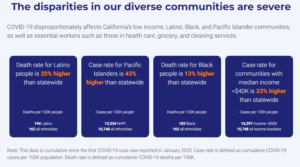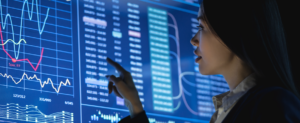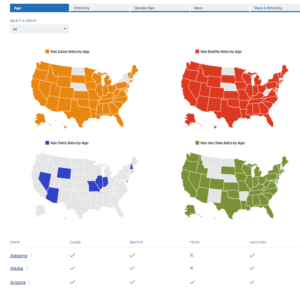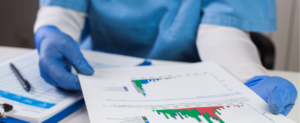
Center for Preparedness and Response, Division of Emergency Operations: CDC
Proactively investing in governance efforts and robust planning, especially with partners, can equip agencies to respond rapidly and effectively during a crisis.
Staffed 24 hours a day, seven days a week, 365 days a year, the Emergency Operations Center at CDC is equipped with highly trained experts who monitor and respond to public health threats. Some of these experts work on the Situational Awareness team in the Center for Preparedness and Response. The center works with agency partners to leverage advanced technology and processes to analyze critical data and information and develop tools leaders can use to help keep people safe during public health emergencies.
During a public health emergency, the team curates data on cases, deaths, lab results, hospitalizations, emergency department visits, vaccinations and social vulnerability to analyze demographic trends and generate daily reports, dashboards and briefings for leadership. These reports provide timely and accurate information on disease severity, affected populations and countermeasures for creating policies and allocating resources to mitigate disease impact.
For the Situational Awareness team, planning is key for emergency operations. For instance, the team proactively develops necessary relationships with international, federal, state, local, academic and nongovernmental partners to prepare data and set up data agreements to collaborate more efficiently during an actual emergency. “Seventy percent of what we do should focus on preparedness, meaning preparing our data and getting agreements established with partners should all be done ahead of time so that when an event happens, teams are not struggling and scrambling—because there is a plan in place,” said Jim Tyson, the chief of the Situational Awareness team at CDC.
When the COVID-19 pandemic hit, however, the team faced unprecedented barriers to its work. Early on, for example, states were focused on the demands of their own response efforts. That sometimes meant there was limited time and resources to devote to managing real-time data sharing with federal agencies. The data the Situational Awareness team needed to produce decision-support products that CDC leadership and agency partners depend on were often incomplete and in a format that required significant manipulation before it could be analyzed, or simply unavailable.
One way the Situation Awareness team navigated these challenges was by using “web-scraping” to collect COVID-19 cases and deaths directly from jurisdictional partner and school-district websites. Although this began manually, the team partnered with CDC COVID-19 leadership and Johns Hopkins University’s Applied Physics Lab to automate this process and aggregate case counts to track the spread of the disease within states and across the country in a timelier manner. To ensure the data was accurate, the team coordinated daily with nongovernmental partners, including Johns Hopkins University’s Coronavirus Resource Center, to identify anomalies in data reporting and validate one another’s data. Tyson believes these exchanges were only made possible because every partner recognized that they could not conduct public health surveillance alone.
“The key here was excellent coordination and collaboration in near real-time through cross-jurisdictional mutual support efforts. It wasn’t so much technology. It was people, culture and process.”
–Jim Tyson, branch chief, Situational Awareness Branch at the Emergency Operations Center, Centers for Disease Control and Prevention
Because this was the first time SARS-CoV-2—the virus that causes COVID-19—had been reported, some data elements, value sets and standardized codes were not in place to report this new and novel virus. To address some of the data standardization issues, the team coordinated with CDC’s COVID-19 response leadership, the Center for Surveillance, Epidemiology, and Laboratory Services, and other CDC centers and partners to create a CDC COVID-19 Information Management Repository. The repository provided states and public health partners a trusted source for COVID-19 informatics resources, including data requirements for COVID-19 data reporting. The COVID-19 Information Management Repository leveraged data interoperability preparedness work over the years between the Situational Awareness team, the Department of Health and Human Services, the National Health Coordinator, and CDC’s Public Health Information Network Vocabulary Access and Distribution System. This repository is maintained by CDC to help improve interoperability of surveillance data systems among selected state, territorial, tribal and local health care and public health partners.
The team was resilient to these data challenges, and noted critical lessons learned, particularly around transforming planning processes for all types of emergencies. “There needs to be a long-term strategy during preparedness activities to establish stronger enterprise systems and data standardization for availability, access and sharing to strengthen future operational responses,” said Roger Harlan, knowledge management team lead at the Situational Awareness team. Organizations have an opportunity to make better use of emergency planning tools that agencies such as the Department of Defense and the Federal Emergency Management Agency use effectively, known as “information exchange requirements” and “information collection planning,” he added. These tools help strengthen processes and governance by requiring agency teams to talk through issues related to plans, roles, partners, data capacity and associated risks prior to any emergency.
WORKFORCE TIP
When the team faced high turnover and burnout among skilled employees who had experience in emergency situations, the management team worked with other agencies and universities to bring in additional personnel for a two- to six-month rotation and train these individuals on COVID-19 response operations. Many of these temporary employees learned quickly how to produce timely data reports, gaining new software skills through screen-sharing—for example, learning Power BI, a data visualization tool. These employees helped the team build short-term capacity and minimize burnout. To learn more about talent exchanges across the federal government, please see the Partnership’s report Trading Places.
BEST PRACTICES FOR FEDERAL LEADERS
- Work with state partner organizations when developing data definitions and standards for states—for example, the Council of State and Territorial Epidemiologists, the Association of State and Territorial Health Officials, and the Public Health Informatics Institute.
- Recruit staff from other agencies or universities on a rotational basis to fill short-term workforce needs.













